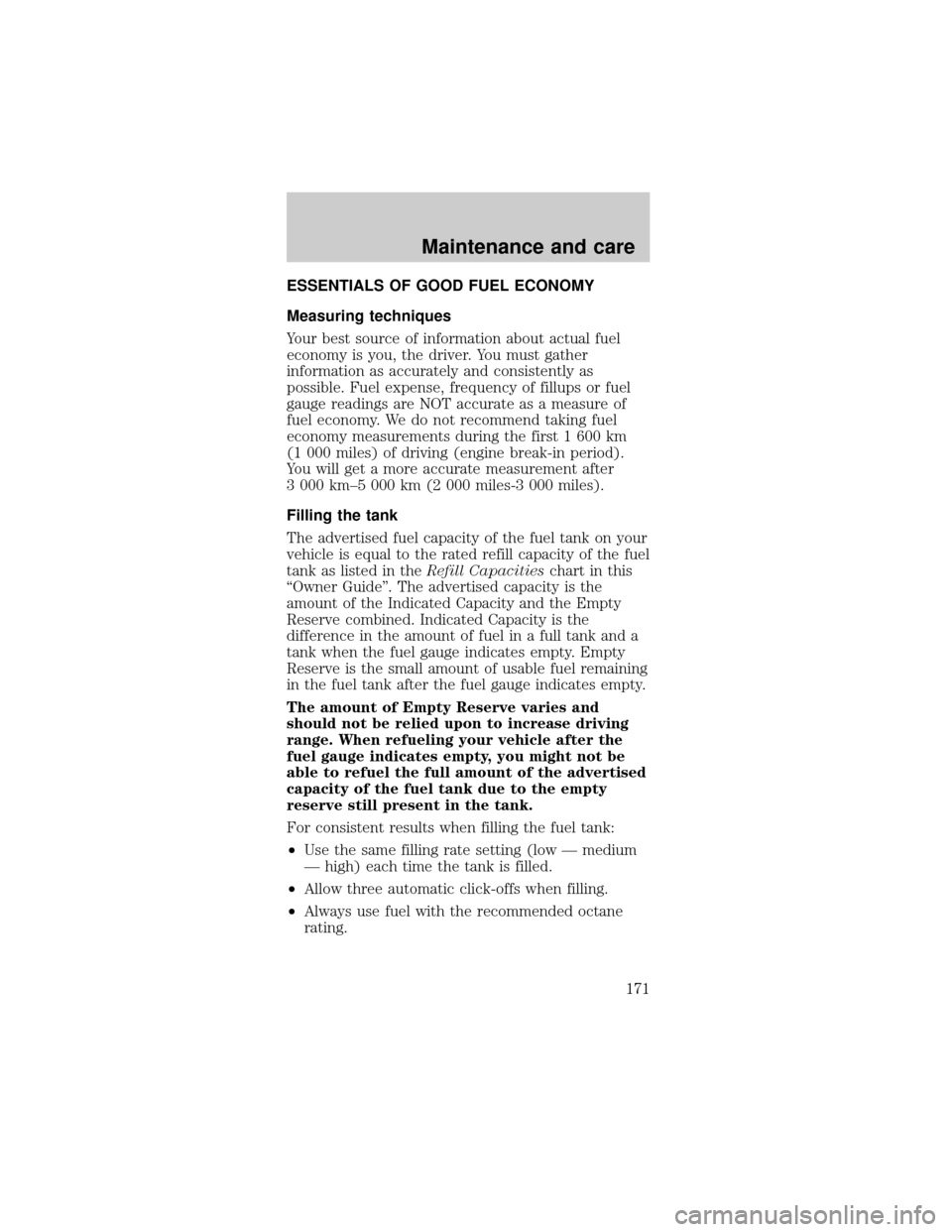Page 15 of 224
Fuel gauge
Displays approximately
how much fuel is in
the fuel tank (when
the key is in the ON
position). The fuel
gauge may vary slightly
when the vehicle is in
motion. The ignition
should be in the OFF
position while the vehicle is being refueled. When
the gauge first indicates empty, there is a small
amount of reserve fuel in the tank. When refueling
the vehicle from empty indication, the amount of
fuel that can be added will be less than the
advertised capacity due to the reserve fuel.
A minimum of six gallons must be added or removed
from the fuel tank in order for the gauge to
instantaneously update. If less than six gallons is the
change, the gauge will take between five to ten
minutes to update.
EF
Instrumentation
15
Page 171 of 224

ESSENTIALS OF GOOD FUEL ECONOMY
Measuring techniques
Your best source of information about actual fuel
economy is you, the driver. You must gather
information as accurately and consistently as
possible. Fuel expense, frequency of fillups or fuel
gauge readings are NOT accurate as a measure of
fuel economy. We do not recommend taking fuel
economy measurements during the first 1 600 km
(1 000 miles) of driving (engine break-in period).
You will get a more accurate measurement after
3 000 km±5 000 km (2 000 miles-3 000 miles).
Filling the tank
The advertised fuel capacity of the fuel tank on your
vehicle is equal to the rated refill capacity of the fuel
tank as listed in theRefill Capacitieschart in this
ªOwner Guideº. The advertised capacity is the
amount of the Indicated Capacity and the Empty
Reserve combined. Indicated Capacity is the
difference in the amount of fuel in a full tank and a
tank when the fuel gauge indicates empty. Empty
Reserve is the small amount of usable fuel remaining
in the fuel tank after the fuel gauge indicates empty.
The amount of Empty Reserve varies and
should not be relied upon to increase driving
range. When refueling your vehicle after the
fuel gauge indicates empty, you might not be
able to refuel the full amount of the advertised
capacity of the fuel tank due to the empty
reserve still present in the tank.
For consistent results when filling the fuel tank:
²Use the same filling rate setting (low Ð medium
Ð high) each time the tank is filled.
²Allow three automatic click-offs when filling.
²Always use fuel with the recommended octane
rating.
Maintenance and care
171
Page 191 of 224
REFILL CAPACITIES
Fluid Ford Part
NameApplication Capacity
Brake
fluidHigh Per-
formance
DOT 3
Motor
Vehicle
Brake
FluidAll Fill to line
on reservoir
Engine
coolant
1Premium
Engine
Coolant3.0L V6
Vulcan
engine11.0L
(11.6
quarts)
3.0L DOHC
V6 Duratec
and
3.4L-32V V8
SHO engine10.0L
(10.6
quarts)
Engine oil
(includes
filter
change)Motorcraft
5W-30
Super
Premium
Motor Oil3.0L V6
Vulcan
engine4.25L
(4.5 quarts)
3.0L DOHC
V6 Duratec
engine5.2L
(5.5 quarts)
3.4L-32V V8
SHO engine6.1L
(6.5 quarts)
Fuel tank
capacityN/A All vehicles 60.6L
(16.0
gallons)
Capacities and specifications
191
Page 223 of 224

Item Information
Required fuel-3.0L V6
enginesUnleaded fuel only -
87 octane
Required fuel-3.4L SHO
V8 engineUnleaded fuel only -
91 octane
Fuel tank capacity 60.6L (16 gallons)
Engine oil capacity
(including filter
change)-3.0L V6 Vulcan
engine4.25L (4.5 quarts). Use
Motorcraft 5W30 Super
Premium Motor Oil,
Ford specification
WSS-M2C153-G.
Engine oil capacity
(including filter
change)-3.0L DOHC V6
Duratec engine5.2L (5.5 quarts). Use
Motorcraft 5W30 Super
Premium Motor Oil,
Ford specification
WSS-M2C153-G.
Engine oil capacity
(including filter
change)-3.4L V8 SHO
engine6.1L (6.5 quarts). Use
Motorcraft 5W30 Super
Premium Motor Oil,
Ford specification
WSS-M2C153-G.
Tire size and pressure Refer to Certification
Label. Inflate temporary
spare to 414 kPa (414
kPa (60 psi)).
Hood release Pull handle under the
left side of the
instrument panel.
Coolant capacity (3.0L
V6 Vulcan engine)
111.0L (11.6 quarts)
Coolant capacity (3.0L
DOHC V6 Duratec
engine and 3.4L V8 SHO
engine)
1
10.0L (10.6 quarts)
Filling station information
223